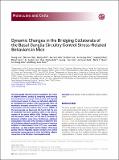| dc.contributor.author | Lee, Y | |
| dc.contributor.author | Han, NE | |
| dc.contributor.author | Kim, W | |
| dc.contributor.author | Kim, JG | |
| dc.contributor.author | Lee, IB | |
| dc.contributor.author | Choi, SJ | |
| dc.contributor.author | Chun, H | |
| dc.contributor.author | Seo, M | |
| dc.contributor.author | Lee, CJ | |
| dc.contributor.author | Koh, HY | |
| dc.contributor.author | Kim, JH | |
| dc.contributor.author | Baik, JH | |
| dc.contributor.author | Bear, MF | |
| dc.contributor.author | Choi, SY | |
| dc.contributor.author | Yoon, BJ | |
| dc.date.accessioned | 2022-03-14T14:38:19Z | |
| dc.date.available | 2021-10-27T20:34:32Z | |
| dc.date.available | 2022-03-14T14:38:19Z | |
| dc.date.issued | 2020-01 | |
| dc.date.submitted | 2019-12 | |
| dc.identifier.issn | 0219-1032 | |
| dc.identifier.uri | https://hdl.handle.net/1721.1/136256.3 | |
| dc.description.abstract | © The Korean Society for Molecular and Cellular Biology. All rights reserved. The basal ganglia network has been implicated in the control of adaptive behavior, possibly by integrating motor learning and motivational processes. Both positive and negative reinforcement appear to shape our behavioral adaptation by modulating the function of the basal ganglia. Here, we examined a transgenic mouse line (G2CT) in which synaptic transmissions onto the medium spiny neurons (MSNs) of the basal ganglia are depressed. We found that the level of collaterals from direct pathway MSNs in the external segment of the globus pallidus (GPe) (‘bridging collaterals’) was decreased in these mice, and this was accompanied by behavioral inhibition under stress. Furthermore, additional manipulations that could further decrease or restore the level of the bridging collaterals resulted in an increase in behavioral inhibition or active behavior in the G2CT mice, respectively. Collectively, our data indicate that the striatum of the basal ganglia network integrates negative emotions and controls appropriate coping responses in which the bridging collateral connections in the GPe play a critical regulatory role. | en_US |
| dc.language.iso | en | |
| dc.publisher | The Korean Society for Molecular and Cellular Biology | en_US |
| dc.relation.isversionof | http://dx.doi.org/10.14348/molcells.2019.0279 | en_US |
| dc.rights | Creative Commons Attribution-Noncommercial-Share Alike | en_US |
| dc.rights.uri | http://creativecommons.org/licenses/by-nc-sa/4.0/ | en_US |
| dc.source | Molecules and Cells | en_US |
| dc.title | Dynamic changes in the bridging collaterals of the basal ganglia circuitry control stress-related behaviors in mice | en_US |
| dc.type | Article | en_US |
| dc.contributor.department | Picower Institute for Learning and Memory | |
| dc.contributor.department | Massachusetts Institute of Technology. Department of Brain and Cognitive Sciences | |
| dc.relation.journal | Molecules and Cells | en_US |
| dc.eprint.version | Final published version | en_US |
| dc.type.uri | http://purl.org/eprint/type/JournalArticle | en_US |
| eprint.status | http://purl.org/eprint/status/PeerReviewed | en_US |
| dc.date.updated | 2021-03-11T18:20:01Z | |
| dspace.orderedauthors | Lee, Y; Han, NE; Kim, W; Kim, JG; Lee, IB; Choi, SJ; Chun, H; Seo, M; Lee, CJ; Koh, HY; Kim, JH; Baik, JH; Bear, MF; Choi, SY; Yoon, BJ | en_US |
| dspace.date.submission | 2021-03-11T18:20:05Z | |
| mit.journal.volume | 43 | en_US |
| mit.journal.issue | 4 | en_US |
| mit.license | PUBLISHER_CC | |
| mit.metadata.status | Authority Work Needed | en_US |
